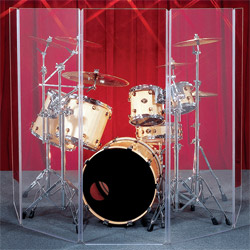Churches with drum cages are inhumane! The plexiglass world that drummers animate themselves in should be the LAST on anyone’s list of acoustic problem solvers, yet have increasingly become the first solution that music ministers, worship leaders and pastors are much too quick to adopt.
Recently, as a listener and worshiper, I’ve personally been subjected to 3 separate and horrific drum setups. In one, the drummer was placed in a completely separate ROOM, with a large plate glass in front of him. He was isolated enough for a studio recording to take place. At another church, the drum cage had a roof on it so low that the drummer had to hunch over to get behind his drums. You couldn’t even hear him, but he was moving his arms, so I guess he was playing. And finally, the ultimate sentence to drummers, a church with TWO enclosures- both with roofs! The first cage for the drummer and the second for the poor percussionist. You could see his shaker and tambourine on a stand next to his wind chimes. His domicile was located next to where the brass section sat. I wondered what these monsters must do to deserve such treatment!
I detest these cages. I abhor them.
The presense of one of them tells me that…
1. As a drummer, I am not trusted to possess any sense of musical dynamics or sensitivity, or any reasonable disciplines of nuance.
2. I am out of control and a “rogue” on the platform, and do not know how to work with the venue, players and singers.
3. What I do is offensive to the ears of the congregation, and not necessarily a calling given to me from the Lord.
4. I am not a valued member of the worship team, nor do I need to really participate in the worship experience. They are simply placating me.
5. The PA system and house mixer are sophisticated and amazing, and I don’t need to be worried about being heard. The pristine skills of the part time mixer are well-honed and his/her ears are finely tuned instruments in themselves.
King David said to MAKE A JOYFUL NOISE and TO PRAISE HIM ON LOUD CYMBALS. Not obnoxious cymbals mind you, but loud nevertheless.
I learned to play drums during a time when the ride cymbal had many more possible sounds than simply beating on it like a trash can lid. The cymbal had various areas and characteristics to it. A rim. A bell. The top. The edge. Underneath. Ridges. You learned about how to read a room, play with finesse and dynamics, and control yourself. You learned to provide a foundation AND COLOR the music where appropriate. I agree with Carl Albrecht’s (see Worship Musician July/August 2009 issue) call for drummers to become more versitile and flexible to their churches acoustic needs. Using “smaller venue” kits, cymbals and drums (if you have that kind of money), and building your stick bag to include brushes, mallets and hot-rods, is sound advice. You can also modify your playing to include some drums and hand percussion. In short, know how to creatively ADAPT to the situation. I’ve been in circumstances where I only used a cymbal, conga, and some hand percussion, and it all worked out great. But the immediate “fix” of acrylic panels and enclosures is a degrading solution to anyone serious about music or worship drumming as a calling.
How many churches and venues are still “Cage Free”? I suspect fewer by the day. With such a beautiful legacy of historically causing the arts to flourish, I think this time the church has adopted an egg.
Worship Team Leaders and Pastors…Think outside the box!
And Drummers…Pursue cage free! ADAPT, don’t adopt.
“Neither do men light a candle, and put it under a bushel,
but on a candlestick; and it gives light unto all that are in the home”. (Mt. 5:15)
Post by Alex MacDougall
Alex is a veteran of the US Christian Music Business not only as a musician, but also in management, especially in marketing and A&R. This article originally featured in Christian Musician Magazine, Reprint used by permission. Blogged at vineyardrecords.co.uk


 Free Band Skills course with all Musicademy or Worship Backing Band DVD orders
Free Band Skills course with all Musicademy or Worship Backing Band DVD orders  Free gift with all Musicademy and Worship Backing Band DVD orders
Free gift with all Musicademy and Worship Backing Band DVD orders  Worship Training Day Ealing London 5 November 2022
Worship Training Day Ealing London 5 November 2022  How to get maximum exposure for your song writing
How to get maximum exposure for your song writing  Streaming online church services: the tech, the tips and the stories from around the world
Streaming online church services: the tech, the tips and the stories from around the world  What do you most struggle with as a worship musician?
What do you most struggle with as a worship musician?  Worship Leader Training: Beginning and Ending Songs Well
Worship Leader Training: Beginning and Ending Songs Well  Learn how to play by ear
Learn how to play by ear  4 tips for making good use of your mic
4 tips for making good use of your mic 

